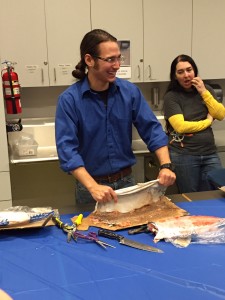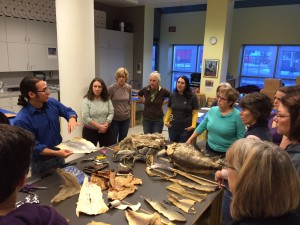Native Alaskans and other people of the north have tanned fish skins for centuries to make bags, shoes, and other useful items. Now fish skin leather is appearing on high-end products from Prada, Nike, and Dior. Commercially produced salmon leather is made in mass in Europe and Chile, but in Alaska, it’s still made by hand, one fish at time.
Artist Joel Isaak slides his thumb along the body of a mostly frozen salmon, prying the fish skin off of the flesh. The process makes a crackling and sucking sound. He grasps the loosening skin tightly with his other hand to create tension.

“Every fish is going to be different, too, for how much it wants to let go of it’s skin and how much it wants to stay, ” he tells a workshop full of women at the Anchorage Museum who have come to learn the ancient art.
The young Athabascan artist has skinned thousands of fish. He started when he was five to help his family prepare salmon for canning. Now he harvests the skins for making clothing and art.
When the skin is off the fish he scrapes off the remaining fat and flesh with a spoon, trying carefully not to rip the thin membrane. Tiny fin bones still protrude from one area and make a harsh clicking noise as he scrapes them clean.
Isaak says he began working with fish skin four years ago after seeing a fish skin basket made by the late Fran Reed.
“So I went and saw it and said ‘I love this! This is so cool! And I want to learn how to do it.’So I started Googling and there’s not a lot of information on the Internet. Just a few sentences here and there.”
So he started experimenting with different ways to degrease the fish using Dawn soap, baking soda, and other chemicals. Before studying art he studied chemistry and his scientific methods and curiosity have stuck with him.
Next he tried tanning the skins with teas or oiling them with different fats and brain matter. He says salmon skin isn’t waterproof unless is treated with oils.
Eventually Isaak met elders, like Helen Dick, who had worked with fish skins and could teach him some of the historical methods.
“When I was working with her I was over scraping them a little bit too much before. And she’s like ‘You’re good. That’s clean enough.’ It was just nice to have someone who had seen their grandparents do it and who had done it before watch what I was doing and make sure I was doing it correctly.”
Isaak says once he learned the traditional ways of making bags and shoes, he started pushing the boundaries and mixing old and new materials.
“Okay, if you start doing hybrids of things, [you ask] where is it really strong and where do you have to go back to the historically correct method?”
Not all of Isaak’s experiments have paid off. His latest pair of fish skin boots developed a hole in the toe after only a month, but he says now he has a better understanding why the historical methods have stuck for so many centuries. But for Isaak, fish skin is also a beautiful art object that connects him to his roots.

“The material itself has it’s own will. It wants to expand and contract when it gets wet. If it’s more humid it will be more flexible. If it’s drier it’s more rigid. It reacts to its environment so it never completely loses that live quality.”
In the classroom, Victoria Cronquist slowly tries to skin her frozen sockeye salmon.
“Salmon are just kind of amazing fish.”
She says she tried skinning salmon on her own, but she hasn’t been very successful. Now she has more hope.
“I’ve been eating salmon for a long time, and it’s kind of sad to throw the skin away. So it’s kind of neat to be able to use it. Especially, possibly to wear it.”
After some effort, the fish releases its skin and Cronquist starts to think about what to make with it.
Anne Hillman is the healthy communities editor at Alaska Public Media and a host of Hometown, Alaska. Reach her at ahillman@alaskapublic.org. Read more about Anne here.





